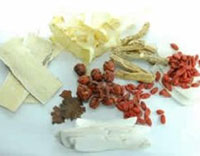 Lately this is my favorite topic and formula to make in my herb granule pharmacy .. because the calls I receive go something like this. “I took it once & I’m off the couch and back to normal”, “I can’t believe those herbs work”, “Why didn’t you tell me before”, “I didn’t take a single motrin this month”, I could go on and on, but you get the idea. So here’s some information about the herbs in the Pacific Herbs PMS Relief Herb Pack & some interesting information on well conducted research on menstrual pain.
Lately this is my favorite topic and formula to make in my herb granule pharmacy .. because the calls I receive go something like this. “I took it once & I’m off the couch and back to normal”, “I can’t believe those herbs work”, “Why didn’t you tell me before”, “I didn’t take a single motrin this month”, I could go on and on, but you get the idea. So here’s some information about the herbs in the Pacific Herbs PMS Relief Herb Pack & some interesting information on well conducted research on menstrual pain.
Don’t mask the pain with NSAID’s try an approach that’s worked for centuries, Chinese Herbal Medicine. An international nonprofit organization, known as the Cochrane Collaboration, studied the effectiveness of Chinese herbal medicine in relieving menstrual pain compared to western drugs. Their conclusion: “Chinese herbal medicine for primary dysmenorrhea roughly doubled pain relief and improvement in overall symptoms compared with conventional Western pharmaceuticals.”
Here are a few common Chinese herbs used for painful menstrual cramps, ( All our in our formula plus more)
1. Dong Gui (Chinese Angelica or Angelica Sinensis) Also known as the “female ginseng,” it is commonly used to regulate the menstrual cycle and relieve menstrual cramps. It also helps to relieve menopausal symptoms, reduce PMS and anemia and to re-establish a menstrual cycle after cessation of birth control pills. It is commonly sold as a single herb tea, bagged or loose. It is considered a king herb or premier herb in Chinese gynecological disease because of its ability to harmonize the blood in Chinese medicine. Dong Gui is also considered antispasmodic. The coumarin chemicals present in this herb may help dilate blood vessels and relax the smooth muscles of the uterus, thus relieving menstrual cramping.
2. Chuan Xiong (Chuanxiong Rhizoma) This herb is also a key medicinal herb for treating pain. It improves blood circulation and promotes the flow of “qi” or vital energy. Chinese women, dating back to the Song Dynasty, used to take this Chinese herb in the form of soup. The soup is called a Four Substance Decoction and includes three other herbs: angelica, red peony and Chinese foxglove. The soup and tea are still used today as a blood tonic to relieve PMS, stop menstrual pain and improve overall health, especially after giving birth.
3. Bai Shao (White Peony Root) White Peony Root nourishes the blood and improves circulation. It is also used for a wide variety of gynecological problems. The peony root is considered a liver tonic in Chinese medicine. By strengthening the liver, it helps to increase the efficiency of protein and fat metabolism, thus inhibiting the excessive synthesis of prostaglandins that may cause an over-active uterus and endometrial pain.
4. Yi Mu Cao (Chinese Motherwort) Leaves from this herb are used to treat menstrual problems. They have been shown to improve blood circulation and clear blood clots that occur in menstrual disorders and after childbirth. The leaves also promote diuresis and relieve edema. Studies on the alkaloid leonurine showed that this substance stimulates the uterus of rabbits, cats, dogs and guinea pigs.2
5. Yan Hu Suo (Corydalis Rhizome) There are two main functions of this Chinese herb: to strengthen blood circulation and to relieve pain. In conjunction with chuan xiong it is known to help both body aches and headaches. Corydalis is related to the opium poppy. Although only 1% in strength compared to opium, it is a very effective pain reliever. The active chemical constituent di- tetrahydropalmatine (THP) is a neuroactive alkaloid with analgesic action that relieves cramping pain. Formulas or groups of Chinese herbs are more beneficial than single herb remedies because the herbs work synergistically for conditions such as menstrual cramps. The Cochran study also stated that: “The herbal remedies were also significantly better at relieving painful cramps and other symptoms than acupuncture or a hot water bottle, with overall promising finding. Chinese herbs overall, whether standardized or tailored, yielded better pain relief than conventional pharmaceutical therapies.” Chinese herbal medicine can be a bit intimidating when you don’t know anything about these herbs, and the five herbs above are only a few of the herbs beneficial for menstrual cramps in the Chinese herbal encyclopedias. Asian pharmacies sell prescriptions of herbal teas and pills daily, and Asian cultures have used herbs successfully for hundreds of years.
By replacing NSAIDs with Chinese herbs, women receive an additional benefit of avoiding the nasty NSAID3 side effects such as upset stomach, heartburn, ulcers and rashes, and liver damage, to name a few. Women don’t need to suffer month after month. You can use Chinese herb supplements to be pain free and PMS symptom free all month long.
Check the research for yourself: Primary source: Cochrane Database of Systematic Reviews Source; Zhu X, et al “Chinese herbal medicine for primary dysmenorrhoea” Cochrane Database of Systematic Reviews 2007;3: CD005288.
- Chinese Medicine Program at the University of Western Sydney.1 (fourth issue for 2007 of The Cochrane Library)
2. Yin, J. Modern Research and Clinical Application of Chinese Materia Medica (2) pp 218-219 Beijing: Chinese Medical Classic Press.


oh i just thought that paracetamol is safer than ibuprofen.
whoah this blog is great. I love studying your posts. You recognize, many individuals are hunting around for this info, you can help them greatly.